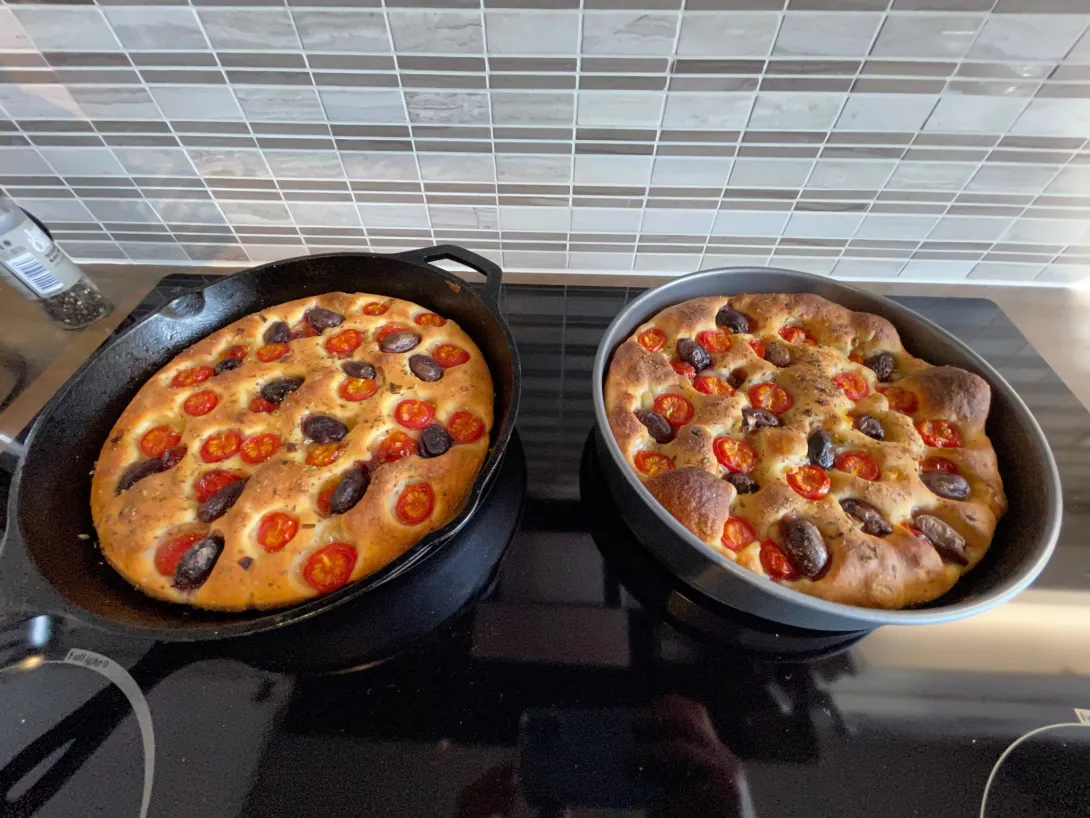
I had some success with my last focaccia and wanted another go at it to improve the crumb. This time I did a direct dough and baked it same day. That bake had an overnight cold retard. I also extended the proof to 5.5 hours from the original recipe posted by Maurizio on The Perfect Loaf. What follows is my adjusted recipe for one or two 9” pans and adjusted instructions.
9” round pan
Total dough weight 450 g
Levain 19%
Hydration 76%
Weight | Ingredient | Baker’s Percentage |
95g | All-purpose flour 10% protein | 38.4% |
131g | High protein bread flour 13% protein | 61.6% |
4.5g | Extra virgin olive oil | 2.00% |
172g | Water | 76.00% |
4.13g | Salt | 1.80% |
43g | Levain (100% hydration) | 19.00% |
Total flour 247.5g
Levain build 1:6:6 75ºC 8-9 hours
4 g starter + 24 g water + 24 g bread flour
9”x13” pan or two 9” round pans
Total dough weight 900 g
Levain 19%
Hydration 76%
Weight | Ingredient | Baker’s Percentage |
190g | All-purpose flour 10% protein | 38.4% |
262g | High protein bread flour 13% protein | 61.6% |
9g | Extra virgin olive oil (Jovial Olio Nuovo Organic Olive Oil) | 2.00% |
344g | Water | 76.00% |
8.26g | Salt | 1.80% |
86g | Sourdough starter (100% hydration) | 19.00% |
Levain build 1:6:6 75ºC 8-9 hours
7 g starter + 42 g water + 42 g bread flour
Method
Mix – 9:00 a.m.
This dough can be mixed by hand (I would use the slap and fold technique) or with a stand mixer like a KitchenAid.
To the bowl of a stand mixer fitted with the dough hook attachment, add both the flours, water, salt, and ripe sourdough starter (hold back the olive oil until later in mixing).
Mix on speed 1 for 1 to 2 minutes until incorporated. Then, mix on speed 2 for 5 minutes until dough strengthens and clumps around the dough hook. Let the dough rest in the mixing bowl for 10 minutes.
Next, turn the mixer on to speed 1 and slowly drizzle the olive oil into the bowl while mixing. Once all of the olive oil is absorbed, turn the mixer up to speed 2 for 1 to 2 minutes until the dough comes back together.
Transfer your dough to a bulk fermentation container and cover.
This highly hydrated and enriched dough is wet and loose , it won’t strengthen to the same degree as a typical bread dough.
Immediately after mixing the dough is still very wet and chunky. However, it’s not falling apart or soupy. Resist the temptation to add more flour at this point, as you can see below in the image at the right, by the middle of bulk fermentation it’ll strengthen after several sets of stretch and folds.
Transfer the dough to a covered container for bulk fermentation.
Bulk Fermentation – 9:15 a.m. to 11:15 a.m.
Give the dough 4 sets of stretch and folds, starting 30 minutes after mixing, and a set every 30 minutes thereafter.
Every 30 minutes for the remaining 2 hours of bulk fermentation gently stretch the dough, with wet hands, toward the corners of the rectangular container. The dough will resist stretching and spring back (especially with the oil underneath), but don’t force it—each time you stretch it’ll relax a bit more and eventually fill the container.
Proof – 11:15 p.m. to 3:15 p.m.
Transfer the dough to a deep rectangular pan or two round pans that have been greased with olive oil. If you don’t have a pan with a silicone liner, make sure to heavily oil the pan’s interior so the focaccia doesn’t stick during baking.
At 76-78°F (24-25°C), the dough will proof for 4 hours. This time period is flexible and dependent on the temperature: if it’s cooler, let it proof longer, and conversely, if it’s warm, you might be able to bake sooner.
Every 30 minutes for the first hour, uncover the pan and gently stretch the dough with wet hands to the pan’s edges to encourage it to fill the pan. The dough will naturally spread out during this proofing period, so it’s unnecessary to spread the dough aggressively. Once the dough is mostly spread to the edges, cover the pan and proof for 4 hours.
I felt that the focaccia needed 5.5 hour of proof and would consider going even longer next time.
Top & Bake – 3:15 p.m.
First, dimple the unadorned dough with wet fingers. Make sure the dimples are evenly spaced and go all the way down to the bottom of the pan. Then, drizzle on 1-2 tablespoons of your extra virgin olive oil and sprinkle with herbs and coarse sea salt. If using other toppings, add them now as well—I like to press them into the dough gently.
Bake the focaccia in the oven at 450°F (232°C) until deeply colored on top, about 30 minutes. Rotate the pan front-to-back halfway through this time. Keep an eye on it during the last 5 minutes and pull it out if it’s coloring too quickly, or leave it in longer if you’d like it a little darker.
Let the focaccia cool a few minutes in the pan, then transfer to a cooling rack. It’s fantastic warm from the oven, and best on the day of baking, but it’ll keep well for a couple days loosely wrapped in foil (reheat under the broiler before serving).
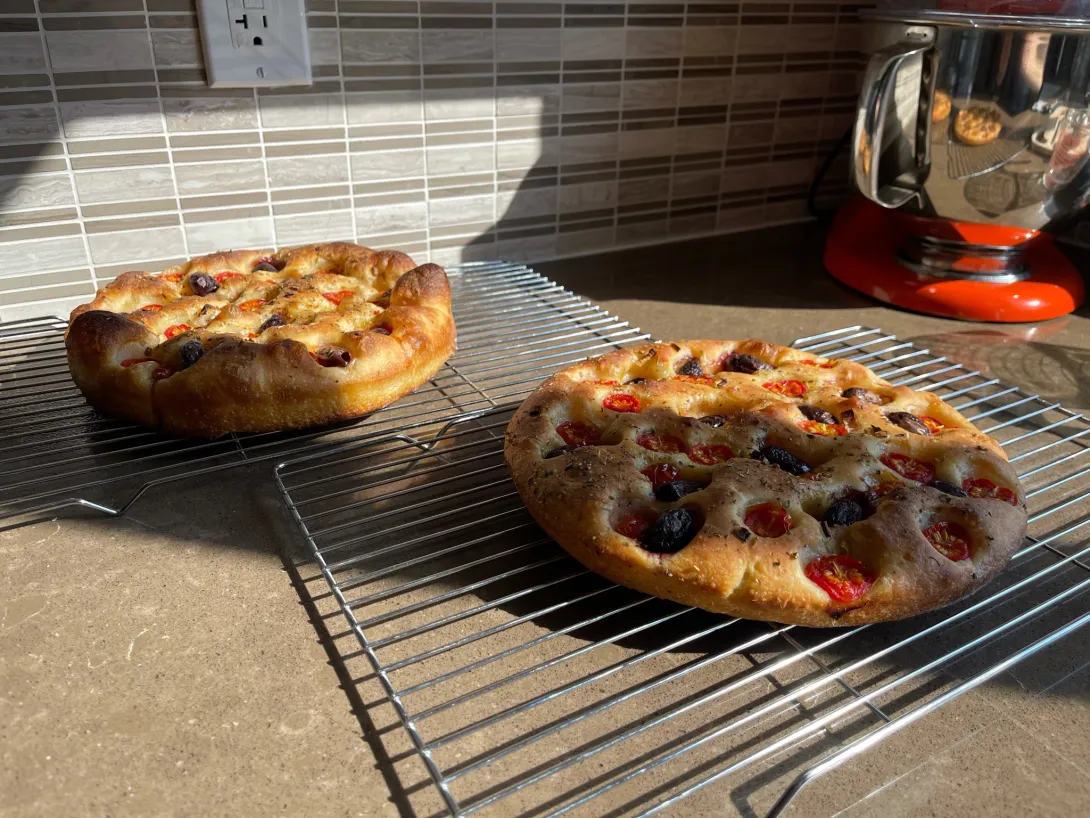
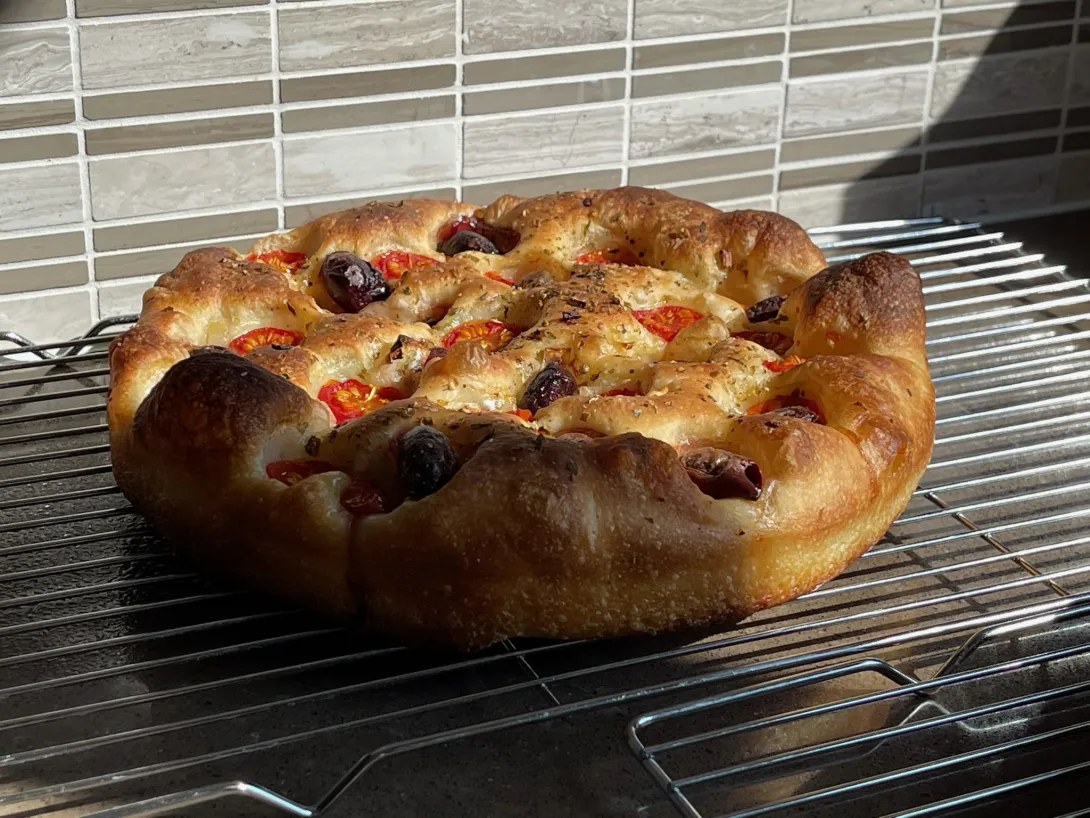
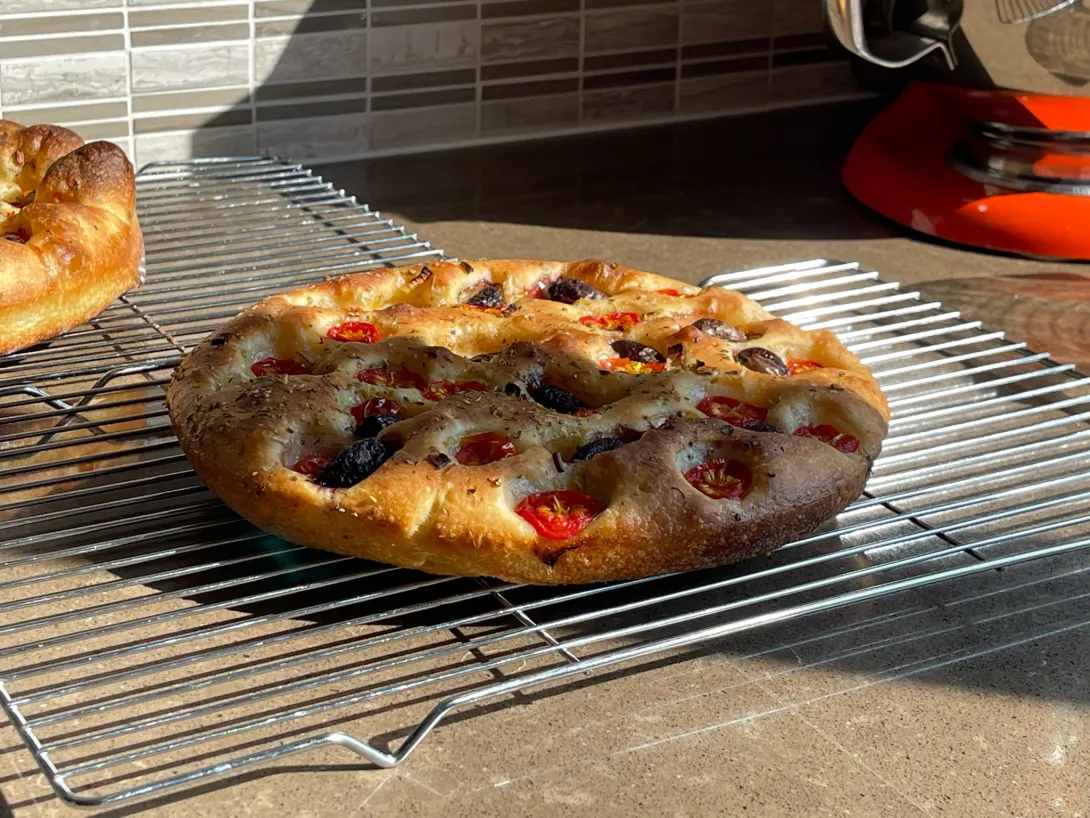
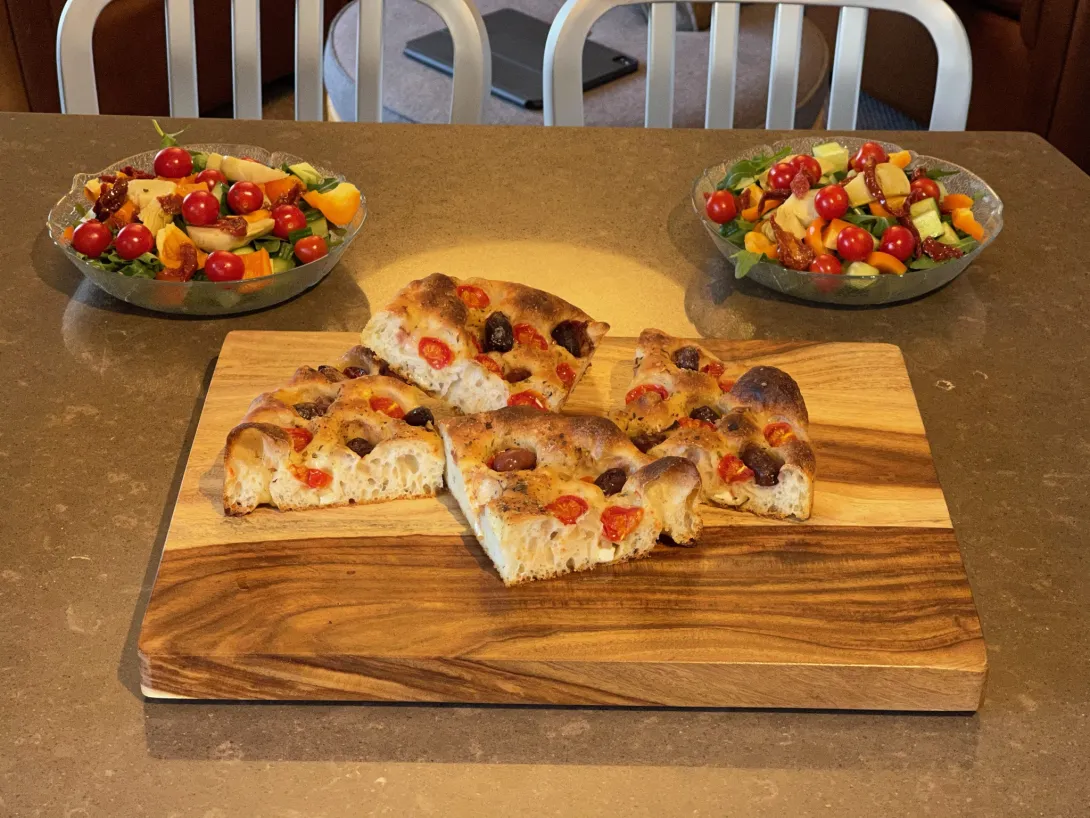
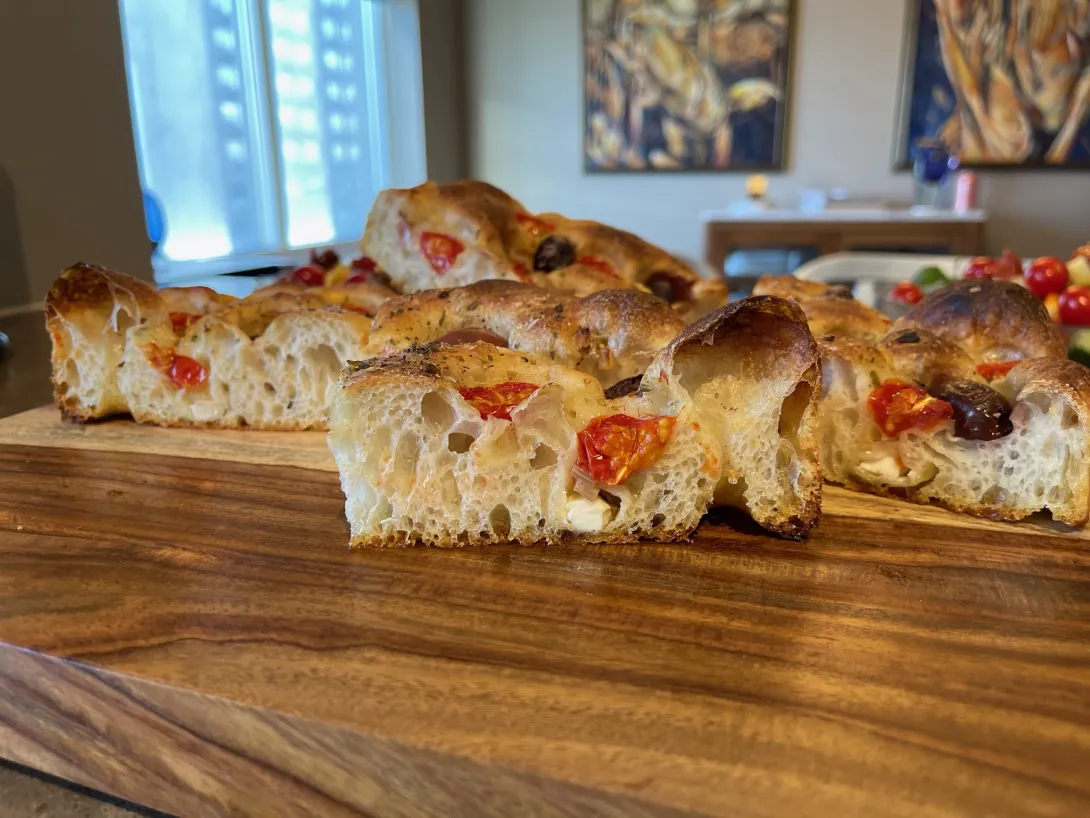
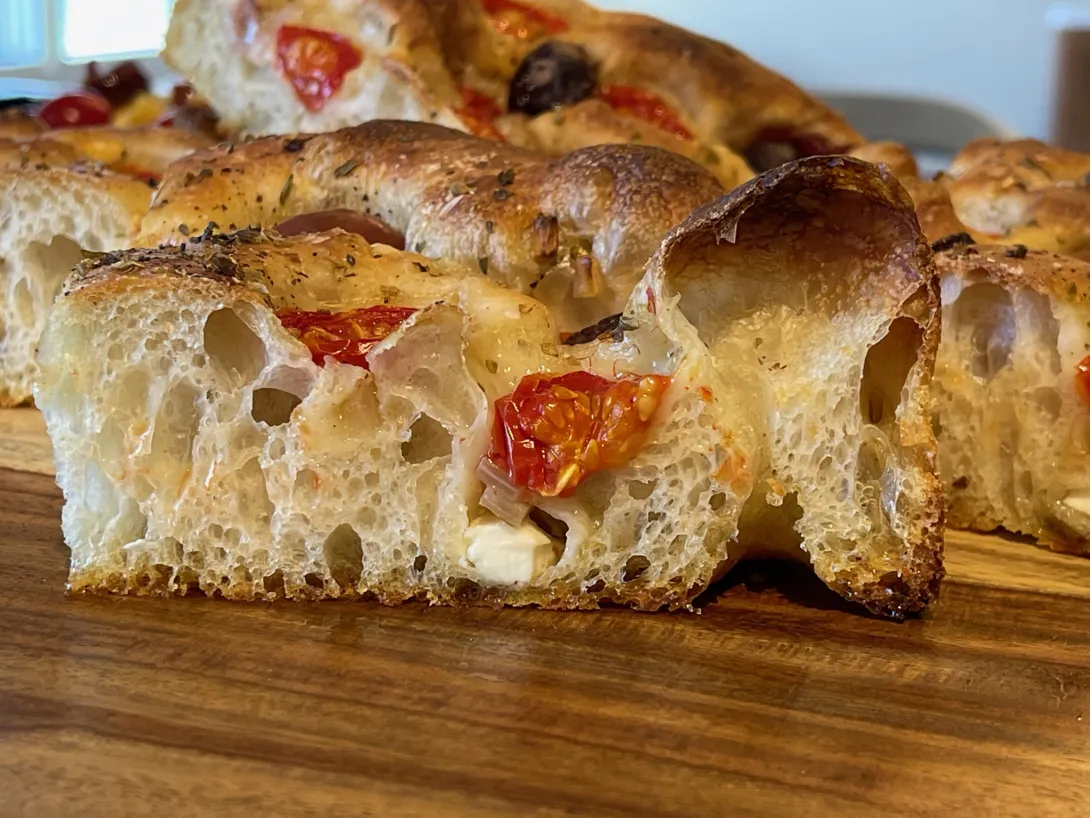
Of note, I found that baking the focaccia in the cake pan resulted in much better oven spring than the one baked in the cast iron skillet. Because both were proofed in their baking vessels the cast iron takes a lot longer to heat and as a result by the time the dough gets hot enough to rise, the top crust is starting to set. Whereas the focaccia baked in the thin cake pan, while also cool at the beginning of baking, heated much more quickly before the crust started to set and ended up with much great oven spring and lovely bubbles which I like to see in focaccia. If I want to make two focaccia at a time again, I may need to purchase another 9” cake pan.
These were topped with locally grown cherry tomatoes, kalamata olives, shallots, feta (the feta and shallots were buried beneath the tomatoes and olives) olive oil, oregano, salt and pepper. This made a wonderful dinner what a simple salad. I love this combination and you should give it a try, feta is wonderful on focaccia.
- Benito's Blog
- Log in or register to post comments
These are beautiful and I haven't stopped thinking about feta focaccia since your first post. This is definitely on top of the list for future bakes.
Thank you very much mdw. Have you tried the viral baked feta pasta yet, it too is yummy if you like feta like we do.
Benny
"Viral baked feta pasta"? Oh boy, I think you've just sent me down a rabbit hole that will greatly improve the happiness of my spouse.
Here’s the recipe and a photo of what I made.
Baked Feta Pasta
First, you'll need to gather your ingredients—and hope that you can still find feta at the supermarket.
The Method, Step-by-Step
Save the pasta water.
"Whenever I cook pasta, I like to save a half cup of pasta water just in case the pasta dish comes out dry. I didn't use it here, but you can certainly add it if you feel the baked feta pasta needs more sauce."
Crowd the baking dish with the cherry tomatoes.
If you want your roasted cherry tomatoes to be saucy, you need to crowd the pan. (Even though we'd never recommend this if you were roasting potatoes or sautéing mushrooms.) "That being said, if you prefer them dry roasted, place your tomatoes in a single layer to allow for air circulation," Jawad says. "But because you want saucy here, I found that an 8"x11" baking dish works perfectly."
Increase the heat for blistered tomatoes.
You can set the oven to broil for two minutes at the end, or turn the temperature to 450°F during the last five minutes of cooking.
I wasn't lying when I said this would improve the happiness of my spouse. Thank you for this, very, very much.
Oh you’re very welcome, always happy to share. Hope you both enjoy it!
Benny
We had this for lunch today. My wife said "oh you made the tik tok pasta!". We both are very satisfied with the results and surprise lunch for her is always a win. Thanks again for sharing the trend, it'll certainly make a regular appearance in the rotation!
Glad you made it for you and your wife and happy that you both enjoyed it. It’s a tasty meal and one that I’ll make again in the future as well.
Benny
Did the baking the bread that rose the highest have anything to do with baking in in a lightweight steel pan as opposed to cast iron?
I do think so Dan. Because one proofs focaccia in their pans, the cast iron starts at proofing temperatures and takes longer to heat up compared with the cake pan, at least that is what I think. As such by the time the dough is heating from below the crust is further along being set when baked in the cast iron.
Tent with foil for the first 5 minutes?
Interesting idea Troy, next time I make a pair of focaccia if I don’t use a different pan I would try that for sure, thanks.
I wonder if baking bread that proofed in a cold cast iron pan would have similar results. Or proof normally (banneton, etc.) then placed in a cold CI.
I know some bakers bake inside a “cold” dutch oven, but it has always been my concern that in the time it takes to heat up the cast iron (it has a high heat capacity) the dough would spread (unless it was low hydration) and that would affect the oven spring and crumb. At least in a dutch oven the crust wouldn’t set early like it did for my focaccia.
I would assume that something similar might happen if one were to bake in a cold cast iron pan or cold baking steel as well.
Benny
Benny have you considered that the dough would be placed in the the pot so that it would spread to the edges of the CI. Because of this the dough could only rise upward.
I thought about greasing the CI with Crisco so that it would have a tendency to stick to the sides. Also it might give the crust some crispness.
What do you think?
I'm thinking about the “Easy Peasy” method. Develop the dough, then place into the CI to ferment. After that bake straight away (or retard) in a pre-heated oven.
Scratch the Cast Iron. A steel cake type pan will get the highest rise. Instead of CI I’d use a cake pan, but the same principle.
I have thought of that, but for me and my dutch oven, the size at the base it too large and I wouldn’t want a loaf that spread that much. If I had a smaller dutch oven it might actually be fine having it confined. However, It I wanted a confined loaf, why wouldn’t I just make it into a pan loaf anyhow?
I’d be interested in seeing how it turned out if you did grease the sides with Crisco, something I’ve not thought of doing. Certainly the bottoms and sides of the focaccia are such a wonderful thin brown crisp texture and I wonder if you could replicate something along those lines with your idea Dan.
Benny
Looks delicious Benny! I think the combination of toppings you could put on that are endless. Really good stuff.
Focaccia are such a blank canvas, your imagination is really the only limitation.
My husband doesn't care for feta (or most things with cheese..... ? All relationships have their hurdles to overcome, lol). But you got my creative side going. Maybe a focaccia with fresh berries when they come in this spring. Dust with some confectioners sugar, or maybe drizzle a lemon glaze, and have with brunch. Hmmmmm......
Oh one I want to do this summer involves topping a focaccia with peaches. I’ve done a pizza with peaches, pecorino Romano cheese and arugula before and it was so delicious. I can’t wait for peach season to try something similar with a focaccia!
I used to hate cheese. It’s only been in the past 1-2 years that I will eat something like Grana Padano and in fact I just started to like old sharp cheddar in the past two months. My gateway cheese was actually goats milk cheese several years ago. Then I gradually tasted other cheeses and finally now in my mid 50’s I’m eating some cheese. In fact, last weekend was the first time I enjoyed a wine and cheese LOL. There maybe hope for your husband yet!
Since it was planned to freeze most of the bread for longer storage, the tomatoes were eliminated. Large whole olives are too pungent for my taste, but the tomatoes and olives look outstanding atop Benny’s bread!
Both the olive oil and the vegetables from Boscoli Olive Salad were used along with various dry herbs on top. The pan was greased with Crisco and some of the Boscoli oil was painted on the top before dressing it.
The following changes were made.
The dough was retarded overnight, but in hindsight it would have benefited from some RT proof before baking. The flavor and crunch was nice. A miniscule amount of Truffle Salt was sprinkled before eating. Given the fact that 1 loaf was given away, and it taste good, most the bread will never see the freezer.
The neighbors get their share.
Thanks, Benny!
Glad you enjoyed the bread Dan. I agree even my most recent bake of this could have used a longer proofing time. From what I’ve seen of bakers getting a really open crumb many of them are even doing an overnight RT final proof so many many more hours than I have done. That might be my next attempt.
Benny